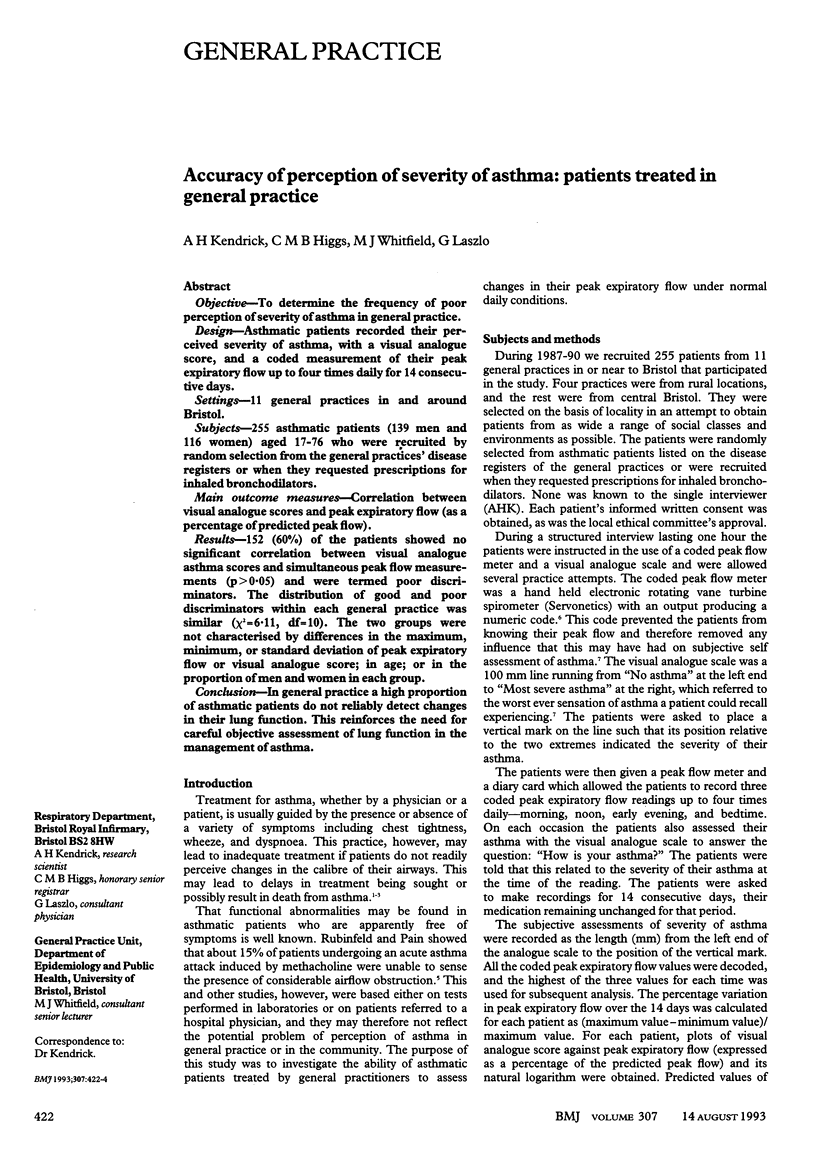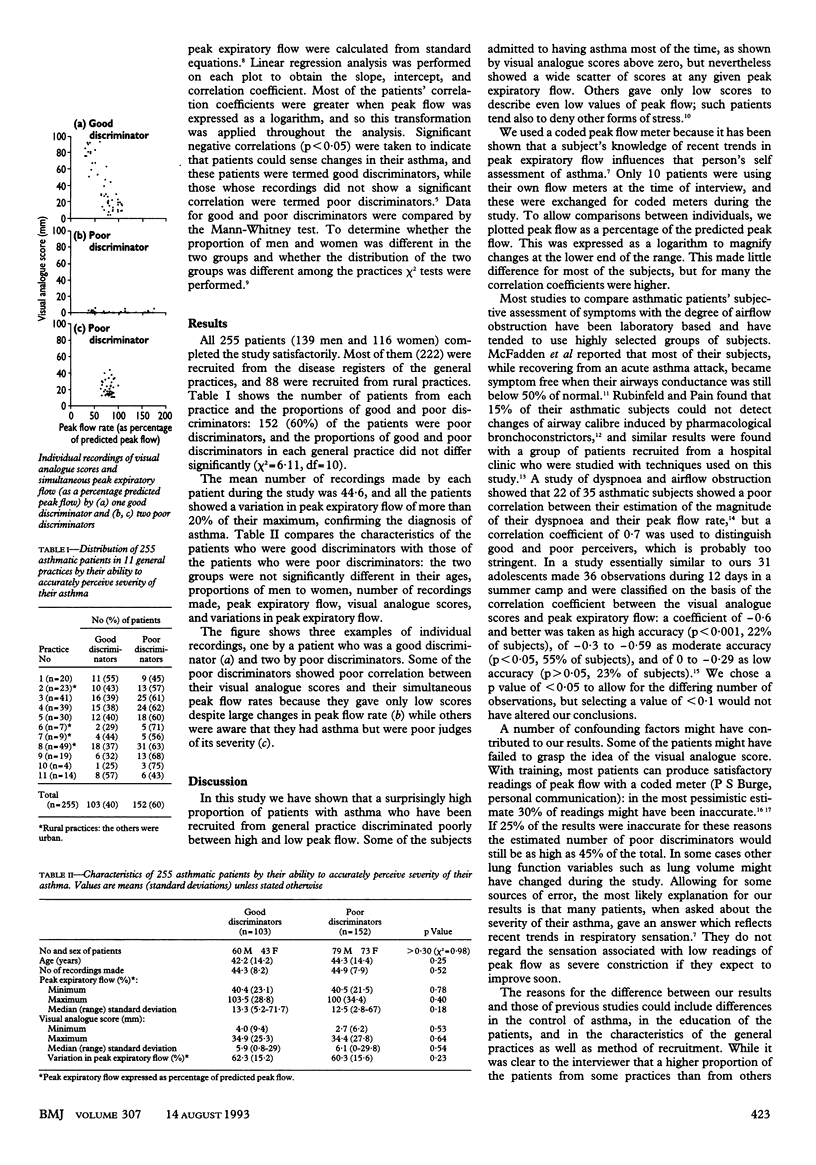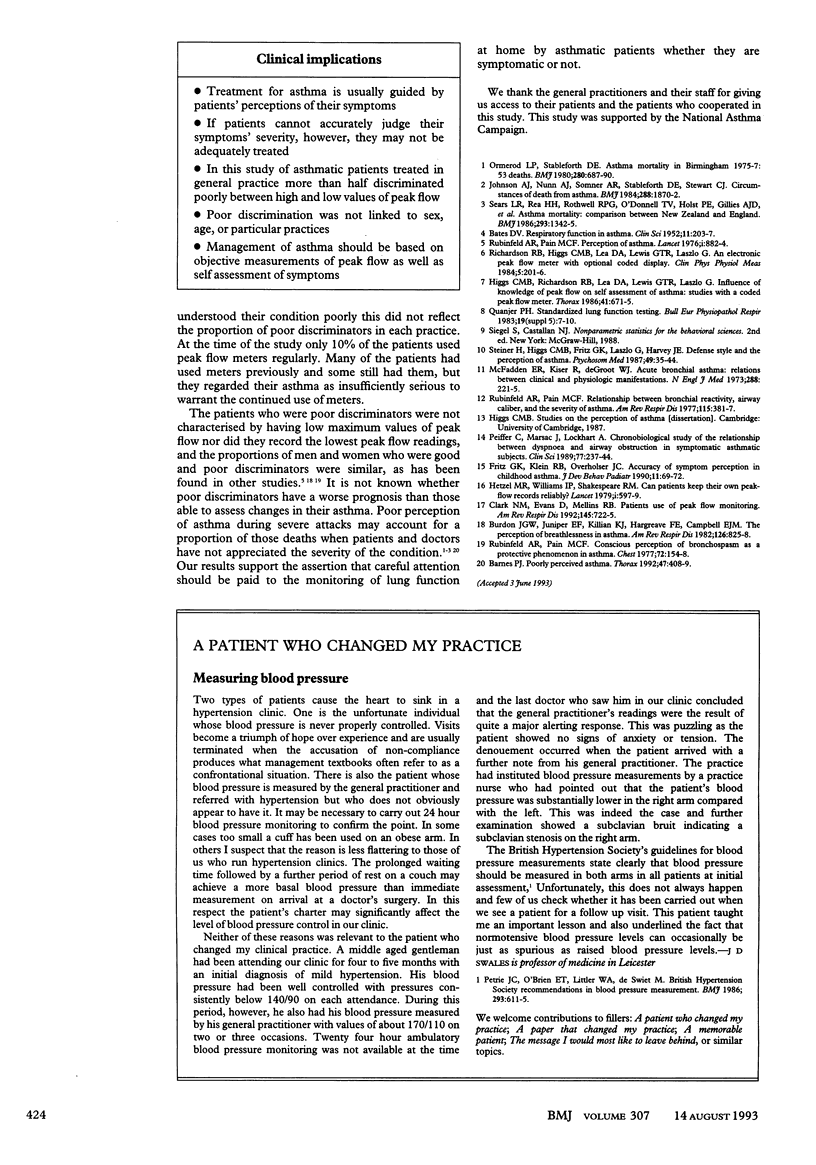Abstract
OBJECTIVE--To determine the frequency of poor perception of severity of asthma in general practice. DESIGN--Asthmatic patients recorded their perceived severity of asthma, with a visual analogue score, and a coded measurement of their peak expiratory flow up to four times daily for 14 consecutive days. SETTINGS--11 general practices in and around Bristol. SUBJECTS--255 asthmatic patients (139 men and 116 women) aged 17-76 who were recruited by random selection from the general practices' disease registers or when they requested prescriptions for inhaled bronchodilators. MAIN OUTCOME MEASURES--Correlation between visual analogue scores and peak expiratory flow (as a percentage of predicted peak flow). RESULTS--152 (60%) of the patients showed no significant correlation between visual analogue asthma scores and simultaneous peak flow measurements (p > 0.05) and were termed poor discriminators. The distribution of good and poor discriminators within each general practice was similar (chi 2 = 6.11, df = 10). The two groups were not characterised by differences in the maximum, minimum, or standard deviation of peak expiratory flow or visual analogue score; in age; or in the proportion of men and women in each group. CONCLUSIONS--In general practice a high proportion of asthmatic patients do not reliably detect changes in their lung function. This reinforces the need for careful objective assessment of lung function in the management of asthma.
Full text
PDF


Selected References
These references are in PubMed. This may not be the complete list of references from this article.
- Barnes P. J. Poorly perceived asthma. Thorax. 1992 Jun;47(6):408–409. doi: 10.1136/thx.47.6.408. [DOI] [PMC free article] [PubMed] [Google Scholar]
- Burdon J. G., Juniper E. F., Killian K. J., Hargreave F. E., Campbell E. J. The perception of breathlessness in asthma. Am Rev Respir Dis. 1982 Nov;126(5):825–828. doi: 10.1164/arrd.1982.126.5.825. [DOI] [PubMed] [Google Scholar]
- Clark N. M., Evans D., Mellins R. B. Patient use of peak flow monitoring. Am Rev Respir Dis. 1992 Mar;145(3):722–725. doi: 10.1164/ajrccm/145.3.722. [DOI] [PubMed] [Google Scholar]
- Fritz G. K., Klein R. B., Overholser J. C. Accuracy of symptom perception in childhood asthma. J Dev Behav Pediatr. 1990 Apr;11(2):69–72. [PubMed] [Google Scholar]
- Hetzel M. R., Williams I. P., Shakespeare R. M. Can patients keep their own peak-flow records reliably? Lancet. 1979 Mar 17;1(8116):597–599. doi: 10.1016/s0140-6736(79)91019-5. [DOI] [PubMed] [Google Scholar]
- Higgs C. M., Richardson R. B., Lea D. A., Lewis G. T., Laszlo G. Influence of knowledge of peak flow on self assessment of asthma: studies with a coded peak flow meter. Thorax. 1986 Sep;41(9):671–675. doi: 10.1136/thx.41.9.671. [DOI] [PMC free article] [PubMed] [Google Scholar]
- Johnson A. J., Nunn A. J., Somner A. R., Stableforth D. E., Stewart C. J. Circumstances of death from asthma. Br Med J (Clin Res Ed) 1984 Jun 23;288(6434):1870–1872. doi: 10.1136/bmj.288.6434.1870. [DOI] [PMC free article] [PubMed] [Google Scholar]
- Martin D. J., Grimbert F. A., Baconnier P., Benchetrit G. Effect of acute hypoxia on lung transvascular filtration in anaesthetized dogs. Bull Eur Physiopathol Respir. 1983 Jan-Feb;19(1):7–11. [PubMed] [Google Scholar]
- McFadden E. R., Jr, Kiser R., DeGroot W. J. Acute bronchial asthma. Relations between clinical and physiologic manifestations. N Engl J Med. 1973 Feb 1;288(5):221–225. doi: 10.1056/NEJM197302012880501. [DOI] [PubMed] [Google Scholar]
- Ormerod L. P., Stableforth D. E. Asthma mortality in Birmingham 1975-7: 53 deaths. Br Med J. 1980 Mar 8;280(6215):687–690. doi: 10.1136/bmj.280.6215.687. [DOI] [PMC free article] [PubMed] [Google Scholar]
- Peiffer C., Marsac J., Lockhart A. Chronobiological study of the relationship between dyspnoea and airway obstruction in symptomatic asthmatic subjects. Clin Sci (Lond) 1989 Sep;77(3):237–244. doi: 10.1042/cs0770237. [DOI] [PubMed] [Google Scholar]
- Petrie J. C., O'Brien E. T., Littler W. A., de Swiet M. Recommendations on blood pressure measurement. Br Med J (Clin Res Ed) 1986 Sep 6;293(6547):611–615. doi: 10.1136/bmj.293.6547.611. [DOI] [PMC free article] [PubMed] [Google Scholar]
- Richardson R. B., Higgs C. M., Lea D. A., Lewis G. T., Laszlo G. An electronic peak flow meter with optional coded display. Clin Phys Physiol Meas. 1984 Aug;5(3):201–206. doi: 10.1088/0143-0815/5/3/004. [DOI] [PubMed] [Google Scholar]
- Rubinfeld A. R., Pain M. C. Conscious perception of bronchospasm as a protective phenomenon in asthma. Chest. 1977 Aug;72(2):154–158. doi: 10.1378/chest.72.2.154. [DOI] [PubMed] [Google Scholar]
- Rubinfeld A. R., Pain M. C. Perception of asthma. Lancet. 1976 Apr 24;1(7965):882–884. doi: 10.1016/s0140-6736(76)92097-3. [DOI] [PubMed] [Google Scholar]
- Rubinfeld A. R., Pain M. C. Relationship between bronchial reactivity, airway caliber, and severity of asthma. Am Rev Respir Dis. 1977 Mar;115(3):381–387. doi: 10.1164/arrd.1977.115.3.381. [DOI] [PubMed] [Google Scholar]
- Sears M. R., Rea H. H., Rothwell R. P., O'Donnell T. V., Holst P. E., Gillies A. J., Beaglehole R. Asthma mortality: comparison between New Zealand and England. Br Med J (Clin Res Ed) 1986 Nov 22;293(6558):1342–1345. doi: 10.1136/bmj.293.6558.1342. [DOI] [PMC free article] [PubMed] [Google Scholar]
- Steiner H., Higgs C. M., Fritz G. K., Laszlo G., Harvey J. E. Defense style and the perception of asthma. Psychosom Med. 1987 Jan-Feb;49(1):35–44. doi: 10.1097/00006842-198701000-00003. [DOI] [PubMed] [Google Scholar]


